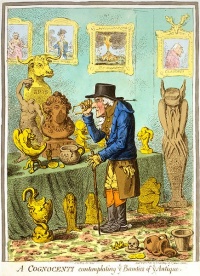Ancient erotica
From The Art and Popular Culture Encyclopedia
|
"While preparations were being made, the damsel sat in a room looking up at a certain painting, in which was represented how Jove is said once to have sent a golden shower into the bosom of Danaë." --Terence's Eunuch, see A painting of Danaë described by Terence in his play 'Eunuchus' |

|
Related e |
|
Featured: |
Ancient erotica is erotica (both ancient literature and ancient art) from ancient history, roughly from about 5th millennium BC until 5th century. It was preceded by prehistoric erotica.
Contents |
Overview
The ancient Greeks painted sexual scenes on their ceramics, many of them famous for being some of the earliest depictions of same-sex relations and pederasty, and there are numerous sexually explicit paintings on the walls of ruined Roman buildings in Pompeii. The Moche of Peru in South America are another ancient people that sculpted explicit scenes of sex into their pottery.
The Milesian tales are the earliest instances of erotic literature in the Western world. They directly influenced Apuleius's The Golden Ass, Petronius's Satyricon in antiquity. They were mentioned in Traitté de l'origine des romans. Milesian saucy and disreputable heroes and spicy, fast-paced anecdote resurfaced in the medieval fabliaux. Chaucer's The Miller's Tale is in the Milesian tradition, as are some of the saltier tales in Boccaccio's Decameron or the Heptameron of Marguerite of Navarre and the later genre of the picaresque novel.
Erotic literature from the Ancient World includes the Kama Sutra, Song of Songs from the Old Testament and the Roman Satyricon of Petronius Arbiter.
West
Precursors: prehistoric erotica
Among the oldest surviving examples of erotic depictions are Paleolithic cave paintings and carvings, but many cultures have created erotic art. Some of the more common images are of animals, hunting scenes and depictions of human genitalia (thought to be fertility symbols). Nude human beings with exaggerated sexual characteristics are depicted in some Paleolithic paintings and artifacts (e.g. Venus figurines).
Middle East
The Graeco-Roman world
The erotica of the Graeco-Roman world is subdivided in Greek erotica and Roman erotica. Examples of what Kenneth Clark termed studies in ideal form from are La Parisienne[1], Venus Anadyomene[2], Venus Kallipygos[3] and the Barberini Faun[4].
Minoan erotica
Greek erotica
- Greek erotica, Homosexuality in ancient Greece, erotica, Greece, pederasty, Sotadic zone, male prostitution in the arts, Sappho
The ancient Greeks often painted sexual scenes on their ceramics, many of them famous for being some of the earliest depictions of same-sex relations and pederasty. A famous heterosexual example is the orgy scene on an Attic cup, attributed to Skythes [5], housed at the Louvre.
Roman erotica
There are numerous sexually explicit paintings and sculpture from the ruined Roman buildings in Pompeii and Herculaneum but the original purposes of the depictions can vary. On one hand, in the "Villa of the Mysteries", there is a ritual flagellation scene that is clearly associated with a religious cult and this image can be seen as having religious significance rather than sexual. On the other hand, graphic paintings in a brothel advertise sexual services in murals above each door. In Pompeii, phalli and testicles engraved in the sidewalks were created to aid visitors in finding their way by pointing to the prostitution and entertainment district as well as general decoration. The Romans considered depictions of sex to be decoration in good taste, and indeed the pictures reflect the sexual mores and practices of their culture, as on the Warren Cup. Sex acts that were considered taboo (such as those that defiled the purity of the mouth) were depicted in baths for comic effect. Large phalli were often used near entryways, for the phallus was a good luck charm, and the carvings were common in homes. One of the first objects excavated when the complex was discovered was a marble statue showing the The Satyr and the Goat in sexual congress, considered so obscene that it was not on public display until the year 2000.
See also
- Sexuality in ancient Greece
- Sexuality in ancient Rome
- Biblical eroticism
- Medieval erotica
- Renaissance erotica
East
- Asian erotica, Taoist sexual practices, Kama Sutra
- Indian erotica, Sexuality in India
- Japanese erotica, Sexuality in Japan
- Chinese erotica, Sexuality in China
- One Thousand and One Nights
South America
The Moche of Peru are another ancient people that sculpted explicit scenes of sex into their pottery. Their purpose however, was much different than that of other early cultures. The Moche believed that the world of the dead was the exact opposite of the world of the living. Therefore, for funeral offerings, they made vessels showing sex acts such as masturbation, fellatio and anal sex that would not result in offspring. The hope was that in the world of the dead, they would take on their opposite meaning and result in fertility.
Reference
See also

